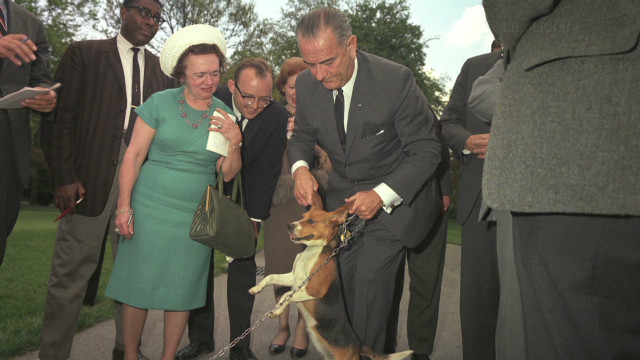Story highlights
- Dog lovers and comedians are sinking their canines into tales of Romney and Obama
- The dustups are nothing new; the White House has a long history of animal occupants
- John Q. Adams' gator, TR's and Coolidge's menageries were legendary, and Taft had a cow
- From Fala to Checkers to LBJ's beagles, treatment of dogs has resonated with the public
For all the headaches on the campaign trail, you would not think a candidate would be hounded by his own dog.
That, however, has been the relentless fate of Republican contender Mitt Romney. A trip to Canada 30 years ago with the family pooch in a car top carrier, has been the gift that just keeps giving to Democrats. They've lampooned him as cruel at worst, foolish at best, with bumper stickers and T-shirts that say "Dogs aren't luggage!" and "Mitt is Mean!"
Republicans have counterattacked by pointing out that President Obama wrote in his own book about eating dog as a child, helping the dog fight become a theme at this year's White House Correspondents Association dinner.
Comedian Jimmy Kimmel nipped at both of them. "If Mitt Romney offers you a ride, call shotgun. And if President Obama starts buttering you, run!"
It would be easy to dismiss all of this as political silliness were it not for one troubling fact: Sometimes the way a president connects with critters can affect the way voters relate to him.
"Presidents and their pets have a long and storied history," says Garrett Graff, a goldfish owner and editor-in-chief at Washingtonian magazine. His theory about why voters take such an interest in such matters: "Most of us don't 'get' Middle East oil politics, and the rise and fall of the G.D.P., but we can 'get' if you connect with a dog or you connect with a cat."
First a little history. Ever since George Washington took office with horses and hounds in tow, presidents have welcomed animals into their lives. A lot of animals.
"John Quincy Adams," Graff says, "actually liked surprising guests with an alligator he kept hidden in a bathtub."
Theodore Roosevelt, famous for his love of the great outdoors, brought a great deal of it indoors when he took the oath. In addition to dogs and horses, Roosevelt had parrots, ponies, bears, a zebra, snakes, lizards, and for reasons lost to time, a one-legged chicken.
William Howard Taft had a cow that which was photographed munching away on the White House grounds. Woodrow Wilson followed suit with sheep. Actually, he pioneered the public relations potential of the flock by using it to keep the grass trimmed during World War One. Old black and white film shows Wilson gazing proudly out of his presidential office as the rams and ewes chew away at the yard, saving Uncle Sam a few mowing fees in a time of austerity.
Calvin Coolidge may seem like the blandest chief executive ever in his photos, but apparently he was a wild man. Like Roosevelt, he brought a zoo with him: Lion cubs, a goose, a bobcat and a raccoon, among other critters. While in office, he was given a pygmy hippo by Harvey Firestone of car tire fame. Wilson named it Billy.
"Both Teddy Roosevelt and Calvin Coolidge gave large parts of their menageries to the National Zoo here in Washington," Graff says, "and even today many if not most of the pygmy hippos here in the United States are descendents of that Calvin Coolidge hippo." Now that's a presidential legacy.
Dogs, however, have always been the most likely pick for first pet, for better or worse.
For example, when Franklin D. Roosevelt was in office, a story went around that he'd accidentally left behind his Scottish terrier, Fala, during a tour of the Aleutian Islands, and then sent the Navy back to rescue the dog. Critics howled over the supposed waste of taxpayer dollars. FDR, however, neatly mows them down on a scratchy old bit of film.
"Well, of course, I don't resent attacks," he said, his lantern jaw jutting over a cluster of clunky microphones, without a hint of smile. "My family don't resent attacks. But Fala does resent attacks!" His audience roared, the critics retreated, and Fala became so famous that the dog is even a feature of the FDR Memorial in Washington, sitting in bronze at the feet of the 32nd president.
Richard Nixon pulled a similar trick back in 1952 when he was Dwight D. Eisenhower's running mate. Defending himself against accusations of receiving improper gifts, he listed his kids' dog, Checkers, as one of them. "And I just want to say right now," Nixon told a television audience, "that regardless of what they say about him, we're going to keep him." Voters ate it up. Nixon humanized himself in one sentence more than he would in an entire career. The "Checkers Speech" became a political legend.
It does not always go well. Lyndon Johnson picked up one of his beagles by the ears, and heard dog lovers howl from coast to coast. In his classic Texas form, Johnson eventually talked his way out of it, but not without a few scratches.
Still, one has to wonder, with all the potential for things to go wrong with a dog in the White House, why do presidents almost always have one? Graff has a theory on that, too: "The presidency is a very lonely undertaking, and I think there are many moments in the White House where what you really want to do is take your pet for a walk."





